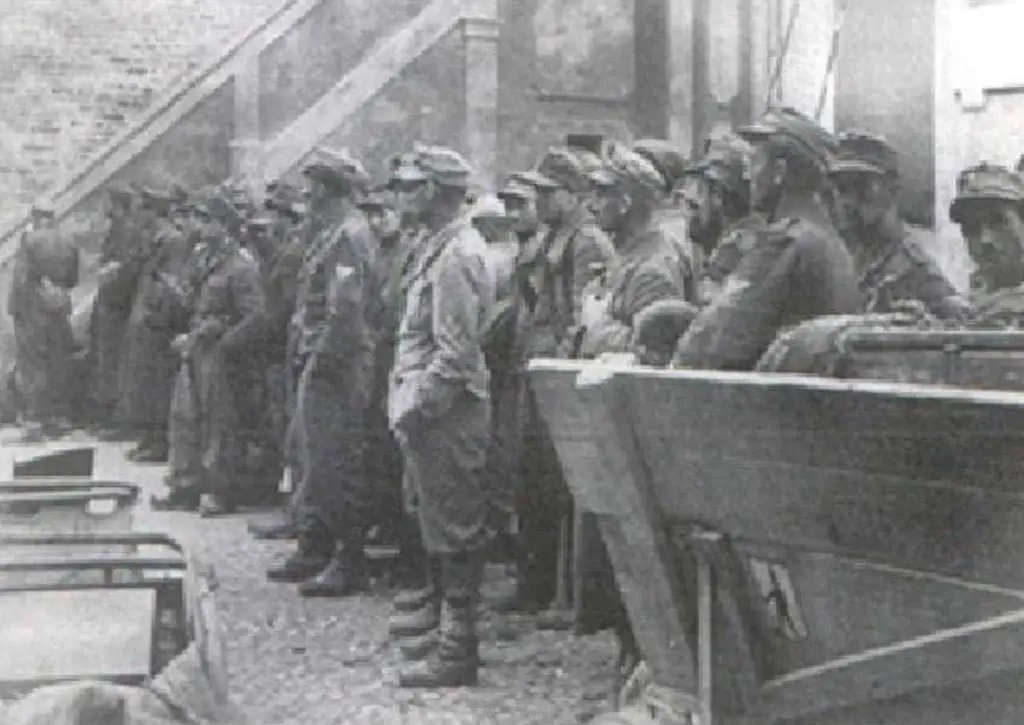Operation Herring occurred between 19-23 April 1945 in which Italian Nembo and “F” Recce paratroopers successfully created havoc in the German rearguard and disrupted their retreat.
An Important Airborne Operation
On 26 March 1945, General Richard McCreery, commander of the VIII British Army, asked the Folgore combat group to pick five officers and 100 paratroopers from the Nembo Regiment willing to volunteer for an important airborne operation. The “F” Recce Squadron received a similar request. This important assignment would become known as Operation Herring.
The Nembo comprised of four platoons of three squads each, commanded by Tenente Guerrino Ceiner. The first three platoons received the number of their original battalions. The fourth comprised of volunteers from the artillery company, mortars company, Engineers and Carabinieri. In total the unit included five officers, 13 NCOs, and 93 paratroopers.
Paratroopers received intense special training under the care of Major Ramsay from the Parachute Regiment during the beginning of April. Particular attention was dedicated to training in night fighting and sabotage.
Given the importance of the mission, Italian paratroopers tested all automatic weapons used by the Allied troops, but the choice fell upon the more reliable M.A.B. 38/A, the “mitra Beretta”, while pistols, daggers, and explosives came from the standard equipment of British Special Forces. The training ended with practice jumps using British jump gear and American aircraft at Gioia del Colle.
Objective of Operation Herring
On 19 April 1945, Maj. Ramsey briefed the commanders of the airborne patrols who were to take part in Operation Herring, which consisted of a jump behind enemy lines south of the Po river. The Nembo was assigned the DZ among Poggio Rusco (Mantova) and Revere-Ostiglia on the Po, while to the “F” Squadron was assigned an area more southwards, among Mirandola, Medolla, S. Felice Sul Panaro and Finale Emilia.

Italian paratroopers take part in Operation Herring in April 1945.
The goal of the mission was to attack withdrawing enemy troops, sabotaging of telephone lines, creating obstacles in the withdrawal path of the enemy, and, last but not least, saving of bridges and other structures that might be useful to the progression of the Allied advance.
Between 8:45 and 9:15 pm, 14 C-47 aircraft took off from Rosignano-Solvay airport (near Leghorn). Before they left, General McCreery sent the paratroopers a wireless message offering good wishes underlined with the importance of the mission in the final offensive on the Italian front. At drop-time, the aircrafts met intense flak. In spite of the difficult conditions, the jumps proceeded normally, at a height between 3,000 and 1,000 feet.
The eight planned DZs could not be clearly identified and some paratroopers landed 40 kilometers away from the expected landing point. The Germans reacted violently, but the paratroopers scattered in groups of two, three, or four men, fighting bravely without any link to one another. The paratroopers attacked the Germans everywhere; sabotaging, ambushing motor-convoys, blocking or mining withdrawal paths, destroying vital logistic centers, emplacements, HQs, and defusing mines and explosives placed by the Germans to slow down the Allied advance.
Results of Operation Herring
This action, which lasted 72 hours, ended with important achievements. The ascertained German losses were:
- 481 dead and 1,083 prisoners
- 44 mechanized transport destroyed or immobilized
- 150 captured including six armored cars, two tanks, and five guns
- 77 telephone lines destroyed and three bridges saved

Captured German prisoners at Lambertini Castle during Operation Herring.
Germans shot some civilians, as well as a few Italian soldiers following their surrender. All of which were reprisals for the paratroopers killing some German prisoners.
The paratrooper’s losses included 19 men belonging to Nembo and 12 from the “F” Squadron. Circa ten were wounded. Among the many acts of bravery that stand out are those of Sottotenente Franco Bagna and Private Amelio De Juliis, who posthumously received the Golden Medal (MOVM). Included in the losses was a British sergeant by the name of Job.